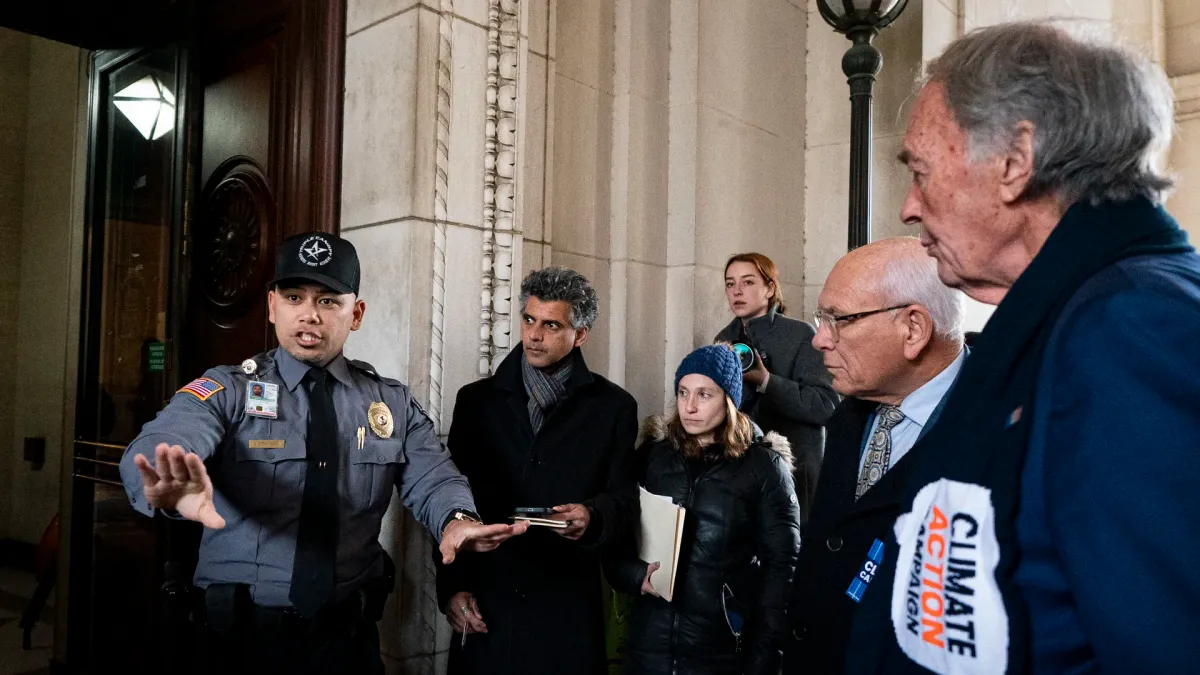The Path to Resistance: Document and Share Everything
The Gang of Three can seize institutions, rewrite code, and fire watchdogs—but they can’t stop millions from documenting it.

When Senator Ed Markey was blocked from entering the EPA headquarters last week by a Musk-payrolled private contractor, the story broke first on TiKTok. A congressional aide's shaky phone footage showed the physical confrontation in close to real-time. Within hours, Reddit posts from former EPA employees explained exactly what systems Musk and his teenagers might access from those offices. By evening, bloggers were studying public records to track unusual patterns in federal systems.
This is what resistance looks like in the information age. What it must look like. While traditional institutions have failed to check DOGE's unconstitutional power - with Congress unwilling to stand up to Trump and Musk openly musing about defying court orders - a distributed ecosystem of journalists, techies, and citizens are documenting, sharing, and spreading information.
The facts are simple. DOGE employees now have access to every American citizen's Social Security numbers, bank accounts, and tax records. They can modify the software that processes, blocks and hides government payments. The dozen Inspectors General who might have investigated were fired before the affair began. The institutional safeguards have been captured. Or rather, they preemptively surrendered.
Trump, Musk, and Vance - the Gang of Three - want the world to feel powerless. But their tech oligarch backers have created the most powerful weapon of resistance possible: their own surveillance and computation infrastructure. The same social networks built to monitor and influence billions can be turned into the world's most effective resistance documentation system. Every phone is a broadcasting station. Every social account is a newspaper. Every group chat is a potential resistance cell - as long as it's on Signal. Every AI app, every open-source LLM, is a tool that can be used to create content, find vulnerabilities, and challenge the powerful.
Information flows faster than it can be contained. When Musk gained control of federal systems through his DOGE appointment, tech workers started mapping what access could mean for his "regulated" companies - SpaceX, Tesla, Neuralink, and xAI.
Millions of eyes are watching. Data journalists are creating visualizations showing conflicts of interest. Citizen archivists are preserving public records before they can disappear. Every leaked document finds its way into the light. Every system change gets recognized, scrutinized, and disseminated by online communities. Every unusual pattern generates crowdsourced investigation.
Social media is reclaimed as critical infrastructure for democratic accountability. Yes, these platforms can spread misinformation - but they can also rapidly surface knowledge. A viral thread explaining the coup reaches more people than a congressional hearing. A well-researched TikTok reaches more people than a Democrat press release.
Eventually, inevitably, the information will find its way to every mind in the U.S. that is still capable of holding a critical thought.
A single news outlet can be silenced. An individual whistleblower can be isolated. But no story can be entirely suppressed when thousands of people are working to spread it.
The hard part is sustaining attention and coordination. When institutions fail, resistance requires maintaining public awareness in the flood of crises, and helping people understand technical threats that are hard to look at, hard to watch, instead of swiping away.
This is about opposing and resisting DOGE - but it's more than that. It's about developing new mechanisms for democratic accountability in the face of systemic and institutional failure and abdication. And it's about answering the critical questions of our age: How do we maintain oversight of government systems when actual oversight is asleep at the wheel? How do we challenge the abuse of power without the courts? How do we translate technical threats into terms that mobilize public interest when there are no tanks in the streets?
Congress won't suddenly find its spine. Courts can and will be ignored. But power depends increasingly on controlling the narrative. When thousands document, interpret, and share what's happening, it becomes harder to abuse power in secret.
This is an asymmetric battle. Those seeking to dismantle democracy have institutional power and technical access. Those resisting have distributed knowledge and the ability to share information instantly. The question is whether an informed populace can check the abuse of captured institutions.
Every authoritarian collapse begins with information. The Berlin Wall fell because East Germans finally saw how their Western counterparts lived. The Arab Spring ignited when citizens could share their reality and revolution through social media. The soviet union crumbled when information could no longer be contained. Now, as DOGE seizes control of America, the great experiment faces its own inflection point.
This is why authoritarians fear communication more than any other force. They can co-opt departments. They can change the passwords. They can rewrite code. They can fire watchdogs. But they can't stop millions of citizens from sharing what they see. Every repressive regime in history had fallen when the truth became unstoppable.
Knowledge isn't just power - it's the prerequisite for change. No one rises up against abuse they can't see. No one resists power they don't feel. But when millions can document, verify, and share information, suppression becomes impossible.
We don't need institutional power. It doesn't do much good in its current form anyway. We need the collective knowledge of citizens sharing what they witness. Every authoritarian in history has eventually discovered that tanks and guns are powerless against the truth.
The path forward is clear: document everything. Share everything. Help others understand what they're seeing. Turn the surveillance architecture into resistance infrastructure. Create so many points of information distribution that they can't possibly control them all. The technical understanding exists. The distribution networks exist. The public are glued to their phones, waiting for information.
In the information era, authoritarian control is ultimately futile. They can seize institutions. They can block investigations. They can threaten individuals. But they can't stop the truth from spreading once it's been set loose.


